Development of 7e’s Guided Inquiry Learning Task on One-Dimensional Motion
- Sittimarriam A. Mawal
- Monera Salic-Hairulla
- Sotero O. Malayao Jr
- Ariel O. Ellare
- Douglas A. Salazar
- 1877-1895
- Jul 12, 2024
- Education
Development of 7e’s Guided Inquiry Learning Task on One-Dimensional Motion
Sittimarriam A. Mawal, Monera Salic-Hairulla, Sotero O. Malayao Jr, Ariel O. Ellare, Douglas A. Salazar
Department Of Science And Mathematics Education, College Of Education, Mindanao State University – Iligan Institute Of Technology
DOI: https://dx.doi.org/10.47772/IJRISS.2024.806142
Received: 29 May 2024; Accepted: 14 June 2024; Published: 12 July 2024
ABSTRACT
This study aimed to develop 7E’s Guided Inquiry Learning Tasks for Grade 7 learners. The developed material will improve the learners’ conceptual understanding of motion in one dimension. The developed material was based on a Grade 7 lesson and aligned with the Most Essential Learning Competency. The 7E’s Guided Inquiry Learning Tasks were face-validated by a panel of experts. The comments and suggestions of the panels were considered to improve the material. Then, after revising the material, it was evaluated by five (5) experts in the field. All indicators on content and mechanics were rated very evident. Hence, the 7E’s Guided Inquiry Learning Tasks are ready for utilization.
Keywords: Motion in one dimension, content, mechanics, 7E’s Guided Inquiry Learning Tasks
INTRODUCTION
Quality education is one of the primary goals of continuously conducting several pieces of research, national and global. However, only a few published research studies conducted in the Bangsamoro Autonomous Region in Muslim Mindanao (BARMM) region pertain to their state of education and the teaching-learning process. Hence, the Minister of Basic Higher Technical Education (MBHTE) emphasized in his speech during the first Provincial Education Summit of Basilan that he said: “I will not settle for less for the Bangsamoro learners.” He wants the optimum outcome for them [9]. Similarly, Science Education issignificant in developing ideas among learners and supporting the growthof scientifically literate and productive members of society [10].
The low proficiency in Science (46%), alarmed the policymakers on the state of education in the BARMM region during the last seventh National Achievement Test (NAT) [12]. The low proficiency on the National Achievement Test in Science subject of Grade 6 learners encourages researchers to choose the previously affected learners, the recent Grade 7 learners, as subjects of this material to help Grade 7 learners enhance their conceptual understanding of science subjects, specifically the physics area. Department of Education (DepEd) has been recognizing the need to address any issues or gaps in achieving quality basic education in the Philippines and initiated multiple programs to enhance learners’ learning issues and continues to discover specific interventions and pedagogy that will aid in boosting students’ cognitive ability and developing their skills. Minister Iqbal of Ministry of Basic, Higher and Technical Education – Bangsamoro Autonomous Region in Muslim Mindanao (MBHTE-BARMM) likewise stresses that education is a major priority of the Bangsamoro government, and it is important to establish, maintain, and support an absolute and integrated system of best education without compromising the national education standard [3]. To combat those challenges, immediate intervention is needed. There was a study conducted revealed that Guided inquiry-based learning effectively enhances students’ literacy skills in aspects of context, competence, knowledge, and all indicators of attitude [2], which can serve as an appropriate method employed to make meaningful learning and the development of science literacy skills. It engages students in systematic, logical, and analytical problem-solving with teacher assistance, allowing them to express their results confidently [7], [2]. This is supported by Edgar Dale in his Cone of Experience, stating that learners learn best with direct, purposeful experience, as in John Dewey’s Learning by Doing model [5] Since inquiry-based learning is one of the effective approaches in enhancing learners’ literacy skills, logical and analytical problems, and providing learners with purposeful experiences, the researcher will apply the inquiry approach in the intervention.
To sum up, there is a need to enhance Grade 7 learners’ conceptual understanding in the physics area, specifically in motion, in one dimension topic based on the low proficiency of Grade 6 learners in the NAT and the highest percentage of students got 74-below in their third quarter. To address this problem and regain learning loss in the learners in the province of Sulu, the researcher developed an intervention on the topic of Motion in one dimension for Grade 7 Science by utilizing a 7E’s Guided Inquiry-based Learning Approach since, according to several studies, this is one of the effective approaches in a teaching Science lesson. Evidently, according to the findings of the local study conducted by Tecson [11], 7E model inquiry-based STEM (iSTEM) digestive system lessons enhanced the teaching-learning process and improved students’ Academic Achievement. With that, this study developed 7E’s Guided Inquiry Learning Task in Motion in One Dimension to enhance the conceptual understanding of Grade 7 learners.
The fundamental objective of this research is to develop and validate the learning tasks in a Guided-Inquiry Learning Approach following the 7E model.
OBJECTIVES
This study aimed to seek the following objectives:
- To assess the need for the development of 7E’s Guided Inquiry Learning Tasks among teachers to better teach the topic motion.
- To assess the need for the development of 7E’s Guided Inquiry learning Tasks among learners in improving their conceptual understanding.
- To develop 7E’s Guided Inquiry Learning Tasks for Grade 7 learners to improve theirconceptual understanding.
METHODS
The following procedures show the development of 7E’s Guided Inquiry Learning Tasks for Grade 7 learners.
- Need Assessment Survey of the Science Teachers and Learners.
A “needs assessment” is a structured set of questions designed to identify needs, analyze their characteristics and origins, and help determine priorities for future action [13]. Before developing 7E’s Guided Inquiry Learning Tasks in One-dimensional motion, a needs assessment was conducted. The needs assessment questionnaire was adapted and modified from the study ofkolong [8]. For Science teachers informants, there were Four (4) of them from two different Secondary Schools in the same division and 40 Grade 7 learners from one public school in the division of Sulu. The survey consisted of open-ended and close-ended questions. Teachers’ and Learners’ responses were thematically analyzed. The needs assessment findings helped the researcher draft the 7E’s Guided Inquiry Learning Tasks.
- Development of the 7E’s Guided Inquiry Learning Tasks
Developing 7E’s Guided Inquiry Learning Task on One-Dimensional Motion underwent many steps to align with the K-12 curriculum and applied the Guided Inquiry Approach to the 7E lesson. The development of
7E’s Guided Inquiry Learning Tasks followed the steps of the Summation Approximation Model (SAM) [1]. The SAM Model has three phases: Preparation, Iterative Design, and Development [6]
Figure 1: Development of the 7E’s Guided Inquiry Learning Tasks by Allen [1]
Figure 1. shows the process of developing 7E’s Guided Inquiry Learning Tasks following the SAM Model. This model aimed a smoothed-running on the instructional design, making it more efficient since it reduced the time and resources typically required compared to other traditional models. Through its unique iterative and collaborative nature, it is more efficient [1].
- Preparation phase (information gathering)
The first phase is the Preparation phase where the researcher initiates the gathering of preliminary information which may include reviewing related literature and studies, conducting a needs assessment for both learners and teachers, specifically Grade 7 learners and Science 7 teachers in identifying topics that immediately need attention and remediation, Identifying approach (Guided Inquiry Learning Approach) to be applied, framework/Model to be followed (7E Model) in teaching the topic and set research goal. After synthesizing all the gathered information during this phase, the researcher concluded by developing the 7e’s Guided Inquiry Learning Tasks on one-dimensional motion to enhance learners’ conceptual understanding.
- Iterative Design phase (savvy stage, project planning, additional design)
savvy stage – in this stage, researchers gather information through a literature review to identify which specific intervention will address the existing learning gap. In this stage, researchers also acquired the experience of teachers and learners on the chosen intervention, the 7E’s Guided Inquiry Learning Tasks. This is a setting stage for successful iterative development.
project planning– after gathering all information on how to address the learning gap, identifying the teaching approach, and assessing the need for the developing of 7E’s Guided Inquiry Learning Tasks, the researchers planned the structure and elements of the learning Tasks.
additional design—In this phase, the first draft of the learning tasks was designed. The panel of experts face-validated it. After acquiring the panel’s comments and suggestions, an additional design was made to further enhance the 7E’s Guided-Inquiry Learning Tasks.
The Iterative phase, where the researcher designed the learning tasks in an Inquiry Approach following the 7E model. The first designed learning task is a prototype of the learning tasks to be implemented in the classroom, and the prototype was first shown to the adviser and three (3) panel members as a sample to be evaluated in terms of the content, choices of examples, alignment of learning tasks to one another, and salient feature from the existing learning materials. The developed learning tasks were compared with existing teachers’ daily lesson logs and other materials used to teach the Motion topic in one specific school. The researcher collects and notes all the comments and suggestions of advisers and the panel experts on the prototype of 7e’s Guided Inquiry Learning Tasks. Revision was made in this phase, considering the inputs of a panel of experts and advisers. After revision was made, it was evaluated for the second time by five (5) Master teachers’ experts in content and pedagogy. When all the indicators in the content and mechanics of the learning Tasks are passed, it will strengthen the learning tasks to help learners enhance their conceptual understanding of motion in one dimension.
- Iterative Development (design proof, alpha, beta)
Lastly, the Iterative development phase is where the researcher developed the final 7E’s Guided Inquiry Learning Tasks (Alpha version) after considering all the suggestions of the adviser, panel members, and five (5) master teachers. After the final revision had been made, the Final validated 7E’s Guided Inquiry Learning Tasks in one-dimensional motion (Beta version) were valid and ready for implementation in the classroom. The Iterative development has three (3) versions, including the Alpha, Beta, and Gold versions. In this development, the researcher stopped at the beta output.
RESULTS AND DISCUSSION
The needs assessment survey results were the basis for the development of the 7E’s Guided Inquiry Learning Tasks. The needs assessment questionnaires were adapted from the study of Kolong [8]. Tables 4.1 and 4.2 show the need assessment results from Science teachers and Grade 7 learners, tables 4.3 and 4.4 show the ratings of validation of five (5)master degree and in-service teachers on the developed 7E’s Guided Inquiry Learning Tasks, and Table 4.5 presents the comments and suggestions of the panel of experts
- Needs Assessment Survey of the Science Teachers to Developed 7E’s Guided Inquiry Learning Tasks.
The needs assessment on teacher, respondents were four (4) Science teachers from two (2) schools in the Sulu division. Table 1 summarises the science teachers’ responses on the need for the development of 7E’s Guided Inquiry Learning Tasks. The researcher created a unique code for every respective respondent for the data coding and analysis to secure the respondents’ privacy. NAR-T means Needs Assessment Response – Teacher, and NAR – L means Needs Assessment Response – Learner.
Table 4.1: Summary of the Responses on Developing 7E’s Guided Inquiry Learning Tasks
| Themes | Codes | Sample Utterances |
| Teaching Experience | Field of Specialization | NAR-T1: “General Science”<br>NAR-T2, NAR-T3: “Biology”<br>NAR-T4: “Social Science” |
| Length in service (teaching profession) | NAR-T1: “5 years”<br>NAR-T2, NAR-T3, NAR-T4: “2 years” | |
| 7E’s Guided Inquiry Learning Tasks Experience | Have no experience | NAR-T1, NAR-T2, NAR-T3, NAR-T4: “Have no experience” |
| 7E’s-GILT is new | NAR-T1, NAR-T2, NAR-T3, NAR-T4: “Specifically 7E’s Guided Inquiry Learning Tasks is new to me, but I am familiar with the 7E lesson plan and Inquiry Approach” | |
| 7E’s Guided Inquiry Learning Tasks in the Classroom | I have not used 7E’s-GILT, only the 7E lesson | NAR-T1, NAR-T2, NAR-T3, NAR-T4: “No, not yet, only 7E lesson, and I seldom implement it.” |
| Needs for the Development | Improve the teaching-learning process | NAR-T1, NAR-T3: “Yes, there is a need to develop 7E’s Guided Inquiry Learning Tasks; this new approach will help teachers assess which approach is effective in teaching specific topics.”<br>NAT-T4: “I think this idea is quite good, as far as quality learning is concerned” |
| Meet the learners’ needs | NAR-T2: “I don’t have any idea about this approach yet. However, I believe there is a need to develop it; it may be one of the solutions to meet the needs of the learners.” |
Table 4.1: Summary of the Responses on Developing 7E’s Guided Inquiry Learning Tasks (continued)
| Themes | Codes | Sample Utterances |
| Enhance learners’ conceptual Understanding | NAR-T1, NAR-T2: “I believe it will help to enhance learners’ conceptual understanding. It is a new approach which will engage learners to learn.” NAR-T4: “The task on motion will help develop the student’s conceptual understanding. Students learn best when they are engaged in a task and when they are the ones who explore and experiment. I believe that this will be a perfect approach for the said topic.” | |
| actively involve students in the learning process, promote critical thinking | NAR-T3: “Yes, I believe that the 7E’s guided inquiry approach will actively involve students in the learning process, promote critical thinking, and more profound conceptual understanding of motion in one dimension.” |
Table 4.1 presents a summary of the teachers’ needs assessment responses. Four themes were identified. The following themes have been determined: Teaching Experience, 7E’s Guided Inquiry Learning Tasks Experience, 7E’s Guided Inquiry Learning Tasks in the Classroom, and the Need for Developing 7E’s Guided Inquiry Learning Tasks. The theme contains some codes based on the teachers’ responses.
Within the themes of teaching experience, there are two (2) codes. The following codes were present: Teachers’ field of specialization and Length of service (teaching profession). Out of four (4) teacher respondents in the needs assessment, two (2) of them were Biology majors, One (1) was a General Science major, and another one was Social Science that are teaching science subjects. Based on the responses in their field of specialization, there was one (1) respondent who is teaching science subjects, but she is a social science major. Findings showed that teachers who teach their field of specialization emphasized more correct performance and application of skills, are more confident regarding their practices and concerned with the content being appropriate to learner level while teachers who teach subjects that are not their field of specialization raised more concerns about the tasks selection, arrangement, and time allotment [16]. For their length of service, three (3) of them have been teaching for two years, and 1 of them has a length of service for five years.Within the theme of “7E’s Guided Inquiry Learning Tasks Experience” of teachers. Only one (1) code was identified, and all of the teachers have no experience in utilizing 7E’s Guided Inquiry Learning Tasks. For the third theme, “7E’s Guided Inquiry Learning Tasks in the Classroom”, two (2) codes were identified. The First code was “7E’s Guided Inquiry Learning Tasks is new”. Four (4) responded that 7E’s Guided Inquiry Learning Tasks are new to them. However, they are familiar with the 7E lesson plan and Inquiry Approach. The Second code, “I have not used 7E’s Guided Inquiry Learning Task, only the 7E lesson”, repeatedly four (4) of them mentioned the second code. Lastly, the fourth theme is “Needs for Development”. In this theme, there are four (4) codes identified. One (1) is “It will improve the teaching-learning process” Three (3) responded to the first code as follows:two (2) teachers responded, ”Yes, there is a need to develop 7E’s Guided Inquiry Learning Tasks; this new approach will help teachers assess which approach is effective in teaching specific topics” and one (1) teacher responded, “I think this idea is quite good, as far as quality of learning is concerned, there is still a need for the development of new strategies like guided inquiry learning tasks to improve learning”. The second code is “Meet the learners’ needs”. One teacher responded, “I don’t have any idea about this approach yet. However, I believe there is a need to develop it; it may be one of the solutions to meet the needs of the learners”. The third code is “Enhance learners’ conceptual understanding”. Two (2) responded similarly as follows, “I believe it will help to enhance learners’ conceptual understanding. It is a new approach which will engage learners to learn”, and one (1) teacher responded “The task on the motion will help develop the student’s conceptual understanding. Students learn best when they are engaged in a task and when they are the ones who explore and experiment. Teacher said “I believe that this will be a perfect approach for the said topic”. Lastly, the fourth code which was taken from the response of the teacher, “actively involves students in the learning process, and promotes critical thinking” ” The teacher said that “Yes, I believe that the 7E’s guided inquiry approach will actively involve students in the learning process, promote critical thinking, and more profound conceptual understanding of motion in one dimension.”
Based on the Science teachers’ responses, the 7E’s Guided Inquiry Learning Tasks still need to be developed.
- Needs Assessment for Learnersto Developed 7E’s Guided Inquiry Learning Tasks.
Table 4.2: Summary of the Responses of Learners on the Needs Assessment on the Development of 7E’s Guided Inquiry Learning Tasks
| Themes | Codes | Sample Utterances |
| Personal information | Previous Science Grade | NAR-L8, NAR-L21: “90” NAR-L9: “93” NAR-L29: “92” NAR-L30, NAR-L31: “88” NAR-L37: “89” |
| Experienced with 7E’s Guided Inquiry Learning Tasks | Have no experienced | NAR-L1- NAR-L16, NAR-L21-NAR-L40 : “Specifically, we have not experienced 7E’s Guided Inquiry Learning Tasks” |
Table 4.2: summarizes the learners’ responses to the Needs Assessment Survey. Only seven (7) learners responded to the first theme, learners’ personal information coded as
| Themes | Codes | Sample Utterances | |
| The 7E stands for | NAR-L1-NAR-L9, NAR-L12-NAR-L16, NAR-L21, NAR-L23-NAR-L26, NAR-L28-NAR-L40: “Elicit, Engage, Explore, Elaborate, Evaluate and Extend | ||
| I have no idea about the 7E’s Guided Inquiry Learning Task or 7E lesson. Topic taught using 7E | NAR-L17-NAR-L19: “I don’t have any idea” | ||
| NAR-L1, NAR-L2, NAR-L4-NAR-14, NAR-16-NAR-L18, NAR-L21, NAR-L23-NAR-L27, NAR-L29, NAR-L30, NAR-L32, NAR-L34, NAR-L35, NAR-L37-NAR-L40: “Performing simple experiment on the topic Mixture and Solution” | |||
| 7E Lesson only once utilized by the teacher | NAR-L1-NAR-L3, NAR-L8, NAR-L12, NAR-L21, NAR-L22, NAR-L25-NAR-L28, NAR-L33, NAR-L34, NAR-L36-NAR-L40: “7E lesson is very interesting, we once taught using that approach. However, that is not enough; it is better to | ||
| experience more 7E lessons”. | |||
| Needs for the Development of 7E’s Guided Inquiry Learning Tasks | Help us better understand the topic | NAR-L4-NAR-L6, NAR-L11, NAR-13, NAR-L15,-NAR-L17, NAR-L19, NAR-L22, NAR-L23, NAR-L30-NAR-L32, NAR-L34, NAR-L39 : “Tausug:“Hounkalagihan, pasalmakatabangini bat kaluhayan kami umingat“In English “There is a need to develop because it will help us to understand the topic easily”. | |
| There is no need to develop | NAR-L7, NAR-L9: “There is no need to develop because it will add to the burden of teachers”. | ||
| Performing learning tasks will help develop conceptual understanding | NAR-14, NAR-L31, NAR-L35: “There is a need to develop because we want to learn more.” | ||
| NAR-L2-NAR-L5, NAR-L7-NAR-L18, NAR-L20, NAR-L21, NAR-L24-NAR-L30, NAR-L32, NAR-L33, NAR-L35, NAR-L39, NAR-L40: “First-hand experience (NAR-L39: maglearntud kami bang kami in mag perform) is effective in learning like performing simple experiments improve our conceptual understanding.” | |||
| It will not help develop a conceptual understanding | NAT-L23: “No” | ||
previous science grade. The second theme is the “Experience with 7E’s Guided Inquiry Learning Tasks ”Five (5) codes were identified in the second theme; these are Have no experience, the 7E stands for, I have no idea of 7E’s Guided Inquiry Learning Tasks or the 7E lesson, topic taught using 7E lesson and 7E lesson only once utilized by the teachers. Thirty-six (36) learners Have no experience learning using 7E’s Guided Inquiry Learning Tasks. Nineteen (19) learners gave what the 7E stands for.
Three (3) learners do not have any idea about the 7E Guided Inquiry Learning Tasks or the 7E lesson. Thirty-one (31) learners Perform simple experiments in the Mixture and Solution lesson using the 7E lesson. They did not provide other topics taught in the 7E lesson other than Mixture and Solution.
This implies that they only utilize the 7E lesson once. Eighteen (18) learners responded to the first code, 7E lesson only once utilized by the teacher. Their response summarizes, “7E lesson is interesting; we once taught using that approach. However, that is not enough; it would be better to experience more 7E lessons. Based on the findings of Rahman & Chavhan, the 7E Model is very effective for both teachers and students, and they recommend utilizing the 7E learning cycle in the classroom for an effective teaching-learning process [14].
The third theme is the Need for developing 7E’s Guided Inquiry Learning Tasks. Four (4) codes were identified. Seventeen learners (17) responded to the first code, Help us better understand the topic. They responded, “Hounkalagihan, pasalmakatabangkamuh bat kami kaluhayanumingat” in Tausug and “There is a need to develop because it will help us to understand the topic easily” in English. Only two (2) learners responded to the second code; there is no need to develop it.
They said, “There is no need to develop because it will add to the burden of the teachers” It means their main consideration is their teacher’s burden. For the third code, three (3) Learners responded as follows: “There is a need to develop because we want to learn more” and thirty (30) learners agreed on the development of 7E’s Guided Inquiry Learning Tasks. They said that “First-hand experience (NAR-L39: mag learn kami, bang kami ngmagperform) is effective in learning like performing simple experiment (their example: they better understand homogenous and heterogenous mixture by performing simple experiment) improve our conceptual understanding”.
Lastly the fifth code, One (1) learners said that “No, it will not help develop a conceptual understanding.
To sum up, the majority of the learners agreed that there is a need to developed 7E’s Guided Inquiry Learning Tasks to improve learners’ conceptual understanding of motion.
- Validation of the Developed 7E’s Guided Inquiry Learning Tasks In One-Dimensional Motion.
Five (5) experts evaluated the Developed 7E’s Guided Inquiry Learning Tasks using the adopted Rubric of Cajayon& Benavides [4] based on the DepEd Learning Resources Management Development System (LRMDS), the experts’ comments and suggestions were considered to improve the learning material. The table below summarizes the experts’ ratings on the categories (content and mechanics ) and indicators for each category of the learning materials.
Table 4.3: Summary of the Expert’s Rating of the Developed 7E’s Guided Inquiry Learning Tasks in One Dimensional Motion in terms of content.
| Indicators (content) | 7E-GILT-E1 | 7E-GILT-E2 | 7E-GILT-E3 | 7E-GILT-E4 | 7E-GILT-E5 | Mean | Description |
| 1. Learning objectives are aligned with the Most Essential Learning Competency (MELC) | 4 | 4 | 4 | 4 | 4 | 4 | Very Evident |
| 2. Learning objectives are appropriately sub-tasked throughout the learning tasks | 4 | 4 | 4 | 4 | 4 | 4 | Very Evident |
| 3. The Learning Tasks contain an appropriate introduction to what students are expected to do and learn in the lesson. | 4 | 4 | 4 | 4 | 4 | 4 | Very Evident |
| 4. The Learning Tasks provide activities or complementary material to enhance the students’ conceptual understanding of the topic. | 4 | 4 | 4 | 4 | 4 | 4 | Very Evident |
| 5. Learning Tasks are logically sequenced from simple to complex following the Guided Inquiry Process Design/7E model. | 4 | 4 | 4 | 4 | 4 | 4 | Very Evident |
| 6. The number of activities is “ample” and appropriate to meet the learner’s individual learning needs. | 4 | 4 | 4 | 4 | 4 | 4 | Very Evident |
| Indicators (content) | 7E-GILT-E1 | 7E-GILT-E2 | 7E-GILT-E3 | 7E-GILT-E4 | 7E-GILT-E5 | Mean | Description |
| 7. The 7E’s-GILT tasks provide varied and interesting activities. | 4 | 4 | 4 | 4 | 4 | 4 | Very Evident |
| 8. Questions and tasks allow for the development of higher-order thinking skills. | 4 | 4 | 4 | 4 | 4 | 4 | Very Evident |
| 9. The directions for activities are simple and clear to guide learners. | 4 | 4 | 4 | 4 | 4 | 4 | Very Evident |
| 10. The 7E’s-GILT provided assessment strategies that are aligned with the lesson objectives. | 4 | 4 | 4 | 4 | 4 | 4 | Very Evident |
| 11. A rubric is provided for assessment strategies that are required for it. | 4 | 4 | 4 | 4 | 4 | 4 | Very Evident |
| 12. Sources reference, supplementary and complementary materials, including images and graphics used in learning tasks, are cited. | 4 | 4 | 4 | 4 | 4 | 4 | Very Evident |
| Note: Resource must score at least 36 points out of amaximum 48 points to pass this criterion. Please put acheck mark( √)ontheappropriatebox. | |||||||
Note: 3.26-4.00 Very Evident 2.51-3.25 Substantial
1.76-2.5 Minimal 1.00-1.75 – absent
Table 4.3 presents the rating of (5) evaluators on the content of the developed 7E’s Guided Inquiry Learning Tasks. It shows that all indicators are very evident in the learning materials. The material gained a total of 48 points and was evaluated as passed. This implies that the 7E’s
Guided Inquiry Learning Tasks meet the content requirements of the DepEd LRMDS.
Table 4.4: Summary of the Expert’s Rating of the Developed 7E’s Guided Inquiry Learning Tasks in One Dimensional Motion in terms of mechanics.
| Indicators (mechanics) | 7E-GILT-E1 | 7E-GILT-E2 | 7E-GILT-E3 | 7E-GILT-E4 | 7E-GILT-E5 | Mean | Interpretation |
| 1. The 7E’s-GILT uses vocabularies within the learner’s level of competence in the language used. | 4 | 3 | 4 | 4 | 3 | 3.6 | Very Evident |
| 2. The length and structure of sentences are appropriate for the learners. | 4 | 4 | 4 | 4 | 4 | 4 | Very Evident |
| 3. The 7E’s-GILT is free from grammatical, factual and computational errors. | 4 | 4 | 4 | 4 | 3 | 3.8 | Very Evident |
| 4. 7E’s-GILT is free from violations of social content guidelines. | 4 | 4 | 4 | 4 | 4 | 4 | Very Evident |
| 5. The total number of pages of the 7E’s-GILT is sufficient to carry out the intended lesson. | 4 | 4 | 4 | 4 | 4 | 4 | Very Evident |
Note: 3.26-4.00 Very Evident 2.51-3.25 Substantial 1.76-2.5 Minimal 1.00-1.75 – absent
Table 4.4: Summary of the Expert’s Rating of the Developed 7E’s Guided Inquiry Learning Tasks in One Dimensional Motion in terms of mechanics. (continued)
| Indicators (mechanics) | 7E-GILT-E1 | 7E-GILT-E2 | 7E-GILT-E3 | 7E-GILT-E4 | 7E-GILT-E5 | Mean | Interpretation |
| 6. The ready-to-print 7E’s-GILT is properly encoded and laid out according to the required specifications for grade level. | 4 | 4 | 4 | 4 | 4 | 4 | Very Evident |
| Total points | 24 | 23 | 24 | 24 | 22 | 23.4 | Passed |
Note: Resource must score at least 18 points out of a maximum 24 points to pass this criterion. Please put a check mark( √) on the appropriate box.
Note: 3.26-4.00 Very Evident 2.51-3.25 Substantial
1.76-2.5 Minimal 1.00-1.75 – absent
Table 4.4 shows the rating of five (5) evaluators on the 7E’s Guided Inquiry Learning Tasks in terms of mechanics. Similarly, all the content indicators’ mean score rating is interpreted as very evident. However, the first indicator got the lowest average mean of 3.6 among the six (6) indicators since two (2) of the evaluators rated the first indicator as 3 interpreted as substantial.
The third indicator got the lower average mean of 3.8 since one of the evaluators rated the specific indicator as 3, interpreted as substantial. It gained a total of 23.4 points, which is interpreted as passed. This implies the mechanics of the learning materials meet the requirement of DepEd LRMDS.
Overall, the content and mechanics of 7E’s Guided Inquiry Learning Tasks meet the highest possible rating, which is interpreted as very evident. Hence, this implies that the developed 7E’s Guided Inquiry Learning Tasks are valid and can be implemented in the classroom.
This is similar to the result of the 7E model inquiry-based STEM rated excellent which implies that it has a positive effect on the performance of the learners and improves the teaching-learning process [11].
- Panel of Experts’ Comments and Suggestions on the Developed 7E’s-GILT
In this section, the researcher presented the panel of experts’ comments and suggestions and the changes made to 7E’ s-GILT. Their comments and suggestions improved the qualityof the 7E’ s-GILT, which also served as a basis for revising it.
Table 4.5: Comments and Suggestions on 7E’s Guided Inquiry Learning Tasks (continued)
| Panel of Experts’ Comments and Suggestions | Old and Revised Version |
| Comment 1. Separate The Teachers Guide and Learning Tasks | 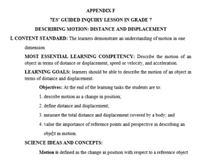 Old Version on comment 1 (As on Teachers Guided and Learning Task) Old Version on comment 1 (As on Teachers Guided and Learning Task)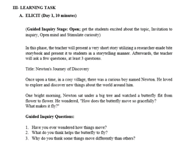 |
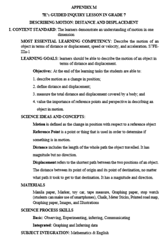 Revised version on comment 1 Teachers’ Guide Revised version on comment 1 Teachers’ Guide |
Table 4.5: Comments and Suggestions on 7E’s Guided Inquiry Learning Tasks (continued)
| Panel of Experts’ Comments and Suggestions | Old and Revised Version |
| Learning Tasks | |
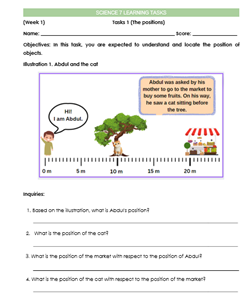 |
|
| Comment 2. Change the ElicitTasks. Flying is not the best representation of motion. | 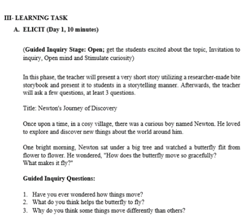 Old version Old version |
Table 4.5: Comments and Suggestions on 7E’s Guided Inquiry Learning Tasks (continued)
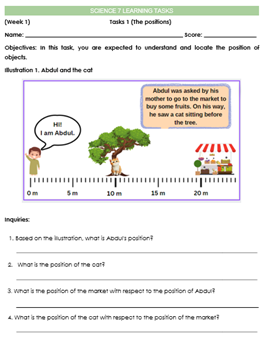 Revised version Revised version |
|
| Comment 3. Tasks instruction is not clear | Old version |
 |
Table 4.5: Comments and Suggestions on 7E’s Guided Inquiry Learning Tasks (continued)
| Revised version | |
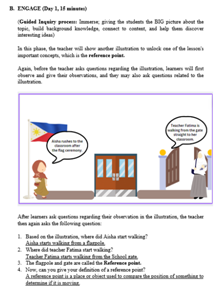 |
Table 4.5 presents the comments and suggestions from the panel of experts and physics content experts during face validation. The panel’s first suggestion was to separate the Teachers’ Guide and Learning Tasks. The Second comment was to revise the tasks in the Elicit stage because flying is not the best representation of motion. The researcher revised it and gave appropriate examples. Third comment: task instruction is not clear. Engage tasks instruction was not clear. Hence, the researcher revised it. You may refer to the table 4.5.
The comments of the panel of experts helped the researcher improve the 7E’s-GILT. Vague examples were removed from the researcher-made lesson to avoid learners’ confusion that will lead to misconceptions. Confusing instruction of the learning tasks was also removed. The 7E’s –GILT was divided into two materials: the teacher’s 7E lesson and the Guided Inquiry Learners’ Tasks. All the comments of the panel of experts led to the Alpha version of the material, which was then validated by five (5) master teachers who were/are currently teaching the topic. Based on the result of the validation of experts on the developed 7E’s Guided Inquiry Learning Tasks, all indicators of content and mechanics reached the weighted mean of 3.9-4.0 which is interpreted as very evident. Hence it is ready for implementation. This is supported by the study of San Miguel [15], that a material that is appropriate and commendable was successful in teaching basic science concepts as supplementary instructional materials.
CONCLUSION
Overall, based on the thematic analysis of the needs assessment for teachers, teachers have not utilized 7E’s Guided Inquiry Learning Tasks in the classroom. Regarding the need to develop 7E’s Guided Inquiry Learning Tasks, all teacher respondents agreed that the material needs to be developed. According to them, this is an exploration of both teachers and learners to discover effective teaching-learning processes. Similarly, based on the needs assessment for learners, most learners have not experienced 7E’s Guided Inquiry Learning tasks. They are only familiar with what 7E stands for. 75% of the learners agreed that there is a need to develop the 7E’s Guided Inquiry Learning Tasks. Hence, the researcher proceeded with developing 7E’s Guided Inquiry Learning Tasks. With regard to the develop 7E’s-GILT, the content of the learning tasks gained a total mean of 4, interpreted as very evident in all indicators and total points of 48, interpreted as passed, and the mechanic gained the lowest mean of 3.6 and the highest mean of 4.0, which is interpreted as very evident as well. In addition, the mechanics gained total mean points of 23.4 interpreted as passed. Therefore, this implies that the developed 7E’s Guided Inquiry Learning Tasks are valid and ready for utilization.
ACKNOWLEDGEMENT
This research project would not have been possible without the support and contributions of many individuals and organizations. I would like to express my deepest gratitude to the Department of Science and Technology-Science Education Institute (DOST-SEI) for the research funds, Mindanao State University – Iligan Institute of Technology for providing the researchers’ place of learning, innovation, and opportunity, I would also like to thank my research adviser and panels, for their invaluable guidance, feedback, and encouragement throughout this study. Their expertise and insightful suggestions were significant for the successful completion of this research, and most especially to our dear parents for their all-out support, and above all to the Almighty God for his Guidance and Wisdom.
REFERENCES
- Allen, M. W. (2012). Leaving ADDIE for SAM: An Agile Model for Developing the Best Learning Experience. American Society for Training &DevelopmentISBN: 978-1-56286-711-9
- Aulia, E. V. (2019). Improving Science Literacy Skills for High School Students Through Guided Inquiry-Based Learning. Advances in Computer Science Research, volume 9, Mathematics, Informatics, Science and Education International Conference (MISEIC, 2019), P. 151. DOI: 10.2991/miseic-19.2019.36
- Bangsamoro Information Office. (2019). BARMM Eyes Better Education.Republic of the Philippines Bangsamoro Autonomous Region Muslim Mindanao. Retrieved from: https://bangsamoro.gov.ph/news/latest-news/barmm-eyes-better-education-system
- Cajayon, J. B., & Benavides, N. G., (2022). Development and Validation of Inquiry-Base Learning Activity Sheets in Life Science. United International Journal for Research & Technology. 03 P. 69. DOI: UIJRTV3I50011
- Cloke, H., (2023). Edgar Dale’s Cone of Experience: A Comprehensive Guide. Growth Engineering. Retrieved from: https://www.growthengineering.co.uk/what-is-edgar-dales-cone-of-experience/
- Elm learning. (2024). The SAM (Successive Approximation Model) Approach to elearning. Retrieved from: https://elmlearning.com/hub/instructional-design/sam-successive-approximation-model/
- Gulo, W. (2008), StrategiBelajarMengajar. Jakarta, PT Gramedia. ISBN: 978-979-025-321-6
- Kolong, A., Salic-Hairulla, M. A., Buan, A. T., &Pitpomtapin, S., (2023). Science Teachers and Students’ Perspectives on SSI-based Instruction: Basis on the Development of SSI- based Curricular Resources. THABIEA JOURNAL OF NATURAL SCIENCE TEACHING. 6 (1).
- MBHTE-BARMM NEWS, (2024). Iqbal: I will not settle for less for the Bangsamoro learners.BANGSAMORO AUTONOMOUS REGION IN MUSLIM MINDANAO. Retrieved from: https://mbhte.bangsamoro.gov.ph/iqbal-i- will-not-settle-for-less-for-the-bangsamoro-learners/
- Meneses, J., (2023). Essential Features and Level of Inquiry of the Activities in the Grade 9 Science Learner’s Material. Research square, P. 2. DOI: https://doi.org/10.21203/rs.3.rs-2527366/v1
- Tecson, C. B., Salic-Hairulla, M. A., &Soleria, H. B. (2019). Design of a 7E model inquiry-based STEM (iSTEM) lesson digestive system for Grade: An Open-inquiry approach. Journal of Physics: Conference Series 1835012034. DOI: 1088/1742-6596/1835/1/012034
- Office of the Senator Win Gatchalian, (2023). Senate Inquiry on state of education in BARMM.Senate of the Philippines 19th Retrieved from: https://docs.google.com/document/d/1VEjg PQF5C63OCsRWd9K8tkT0o6C5MhpH/edit
- Office of Migrant Education, (2001), Comprehensive Needs Assessment, New Directors Orientation. p. 2. Retrieved from: https://www2.ed.gov/admins/lead/account/ pdf
- Rahman, S., &Chavhan, R., (2022). 7E MODEL: AN EFFECTIVE INSTRUCTIONAL APPROACH FOR TEACHING LEARNING. EPRA International Journal of Multidisciplinary Research (IJMR). Volume 8, Issue 1. DOI: https://doi.org/10.36713/epra9431
- San Miguel, N. V., (2021). Effects of 7E Model Inquiry-Based Approach on Student Achievement.International Journal Research Publication.89(1), 46-61; doi:.10.47119/IJRP1008911120212430 58
- Tsangaridou, N., Charalambus, C. Y., and Kyriakides, E. (2023). Preservice Classroom Teachers’ Views and Experiences of Teaching Physical Education: Does Taking Physical Education Specialization Matter? European Physical Review.Volume 30, Issue 2. DOI: https://doi.org/10.1177/1356336X23120308

![Figure 1: Development of the 7E’s Guided Inquiry Learning Tasks by Allen [1]](https://rsisinternational.org/journals/ijriss/wp-content/uploads/2024/07/3555.png)